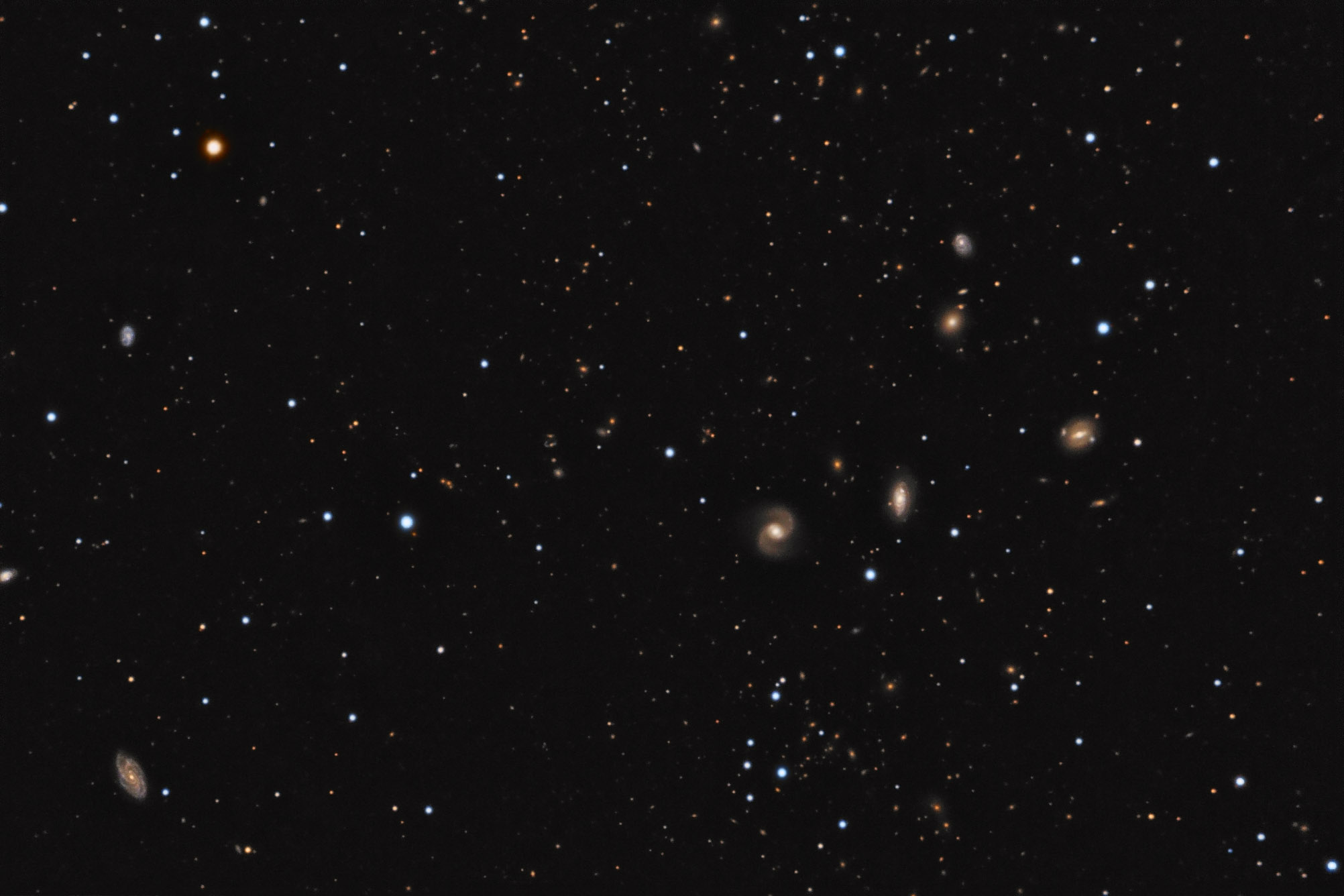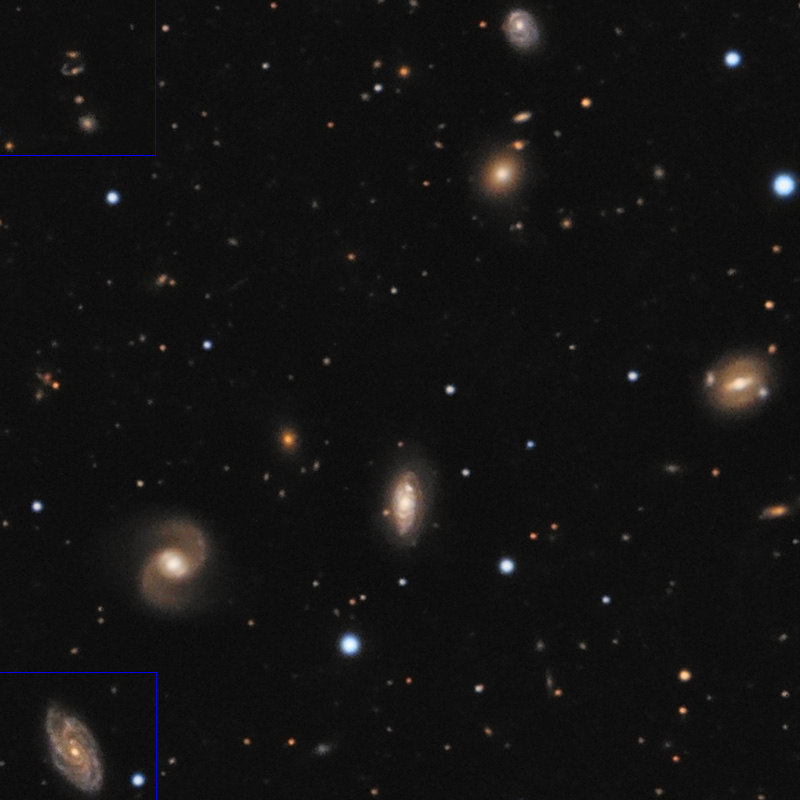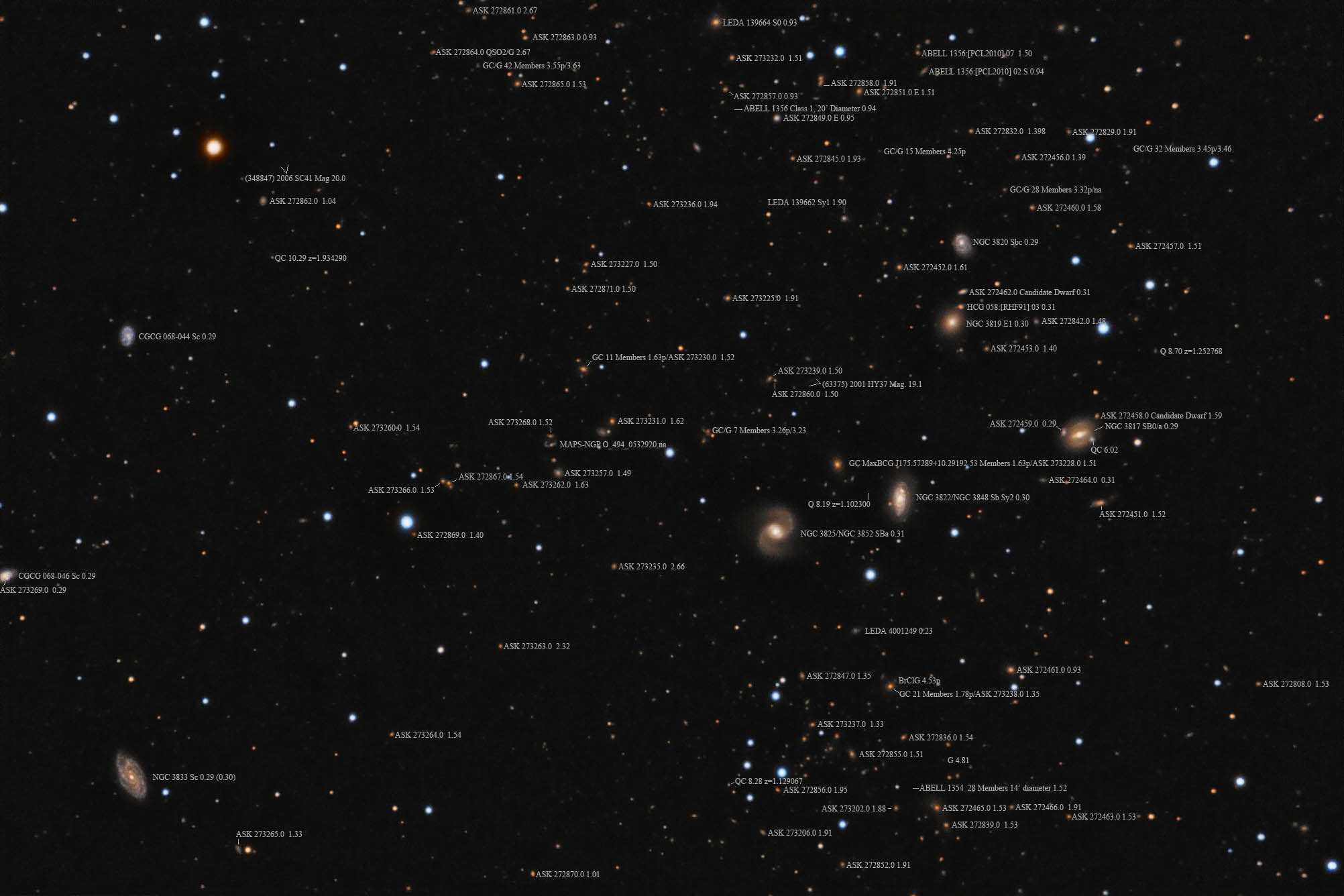Object name: NGC3817Designation(s): NGC3817, NGC3819, NGC3820, NGC3822, NGC3825, NGC3833, ABELL1356, ABELL1354, ABELL1356, Hickson58, This may be one of the busiest fields I've imaged. It certainly resulted in a complex annotated image that took me several times longer than usual. Fortunately, I'd worked ahead a bit knowing this was coming. The field contains Hickson 58, a group of 5 or maybe 8 galaxies many, or all, of which made the NGC catalog as well as two rather nearby Abell galaxy clusters, #1354 at the bottom and #1356 at the top. It also contains many galaxies not in any of these three groups, some of which are quite interesting. Add in that some of the NGC galaxies have two different NGC numbers and things get even more complex.
I'll start with Hickson 58 as that was my target. It is listed as having 8 members at NED and 5 everywhere else and is about 300 million light-years distant in the constellations of Virgo and Leo -- the dividing line is above NGC 3822/3848 and below NGC 3819. The problem is NED lists only 5 members, all NGC galaxies so I can't tell what the other three are or if that is even right. No other source I found says 8. The major ones are NGC 3822/3848, and NGC NGC 3825/3852. Both found By William Herschel on March 15, 1784. So why two designations for each? Here's the explanation at the NGC project: (NGC project site is being rebuilt (very slowly but I got this before it died)
"NGC 3848 is probably NGC 3822, and NGC 3852 is probably NGC 3825. The
two questionable identifications are a pair found by William Herschel on 15
March 1784, III 35 and III 36. He describes them as ``Two on parallel, 3 or 4
arcmin distant. Both eF, vS,'' and assigns a single position to the pair.
Dreyer, in the Notes to his 1912 edition of WH's papers, claims for N3848,
``Observed by Bigourdan, place correct.'' For N3852, he says, ``RA possibly 1
minute too great (see II 64 [NGC 4352]). Not found by Bigourdan.''
This is curious, as Bigourdan clearly states ``Not seen, at least in a sure
way'' for N3848, and ``Not seen'' for N3852. Perhaps there is a note in one
of Bigourdan's Comptes Rendus papers. In any case, Bigourdan has precise
measurements for NGC 3822 and NGC 3825, and identifies them correctly. They
are 2 minutes west (not 1 minute) of WH's positions for N3848 and N3852, and
they match WH's description well."
NGC 3822/3848 is member A of the HCG 58 group and classed as Sb though I've seen S0 (NGC project says S0?) for it that doesn't seem reasonable to me. It was discovered by William Herschel on March 15 1784 and got the NGC 3848 designation by Dreyer. A month later on April 15, 1784, he found it again. Neither he nor Dreyer caught the duplication so it got the NGC 3822 number
NGC 3825/3852 is member B of HCG 58. While redshift puts it as a member of the group its Tully Fisher distance estimate is wildly different at nearly 500 million light-years. So far off I didn't include it in the annotated version. Like NGC 3825/3852 these were discovered on April 15 and May 15 of 1854. Sounds like he had the same positional error one of these nights. I can't find which ones were more accurate.
NGC 3817 is HCG 58C and is considered a triple galaxy. ASK 272459 is on the left and SDSS J114151.70+101809.0 on the right. Buried in the glow of it is a quasar candidate shown on the annotated image. The galaxy has no redshift listed at NED so may or may not be a companion. The left galaxy has virtually the same redshift so likely is a satellite of the main galaxy. The main galaxy is classed as SB0/a at NED and SB0-a at the NGC project. It was discovered by John Herschel on January 18, 1828.
NGC 3819 is HCG 058D. NED lists it as E1 while the NGC Project says E. It was found by John Hershel on January 18, 1828
NGC 3820 is HCG 058E. Ned and the NGC project lists it as Sbc. Its discovery came later on April 29, 1865 by Heinrich d'Arrest.
The only other NGC galaxy is in the lower left corner. It is classed as Sc. It was discovered on April 15, 1784 by William Herschel. While not considered part of Hickson 58 it does lie at about the same distance so likely is part of the same group. It's too far from the others to meet Hickson's compact requirement.
The two Abell cluster's center positions are shown on the annotated image. Abell 1354 is listed as being morphology class III which means it lacks any type of a central large galaxy and is rather disorganized with little concentration. Though ASK 272855 isn't far from the center and larger than the rest there are others nearly as big scattered in the 14 minute field. Abell 1356 is class II-III. Class II clusters are more organized with some condensation toward galaxies not quite large enough to be considered Cd or a Bright Cluster Galaxy. Abell 1356 would be somewhere between II and III. To me, it is very similar to 1354 in that it has two rather large galaxies not far from its center, LEDA 139664 and ASK 272849 that aren't much larger or brighter than several others in the group. Several other galaxy groups are seen throughout the image.
One galaxy I wanted to know more about is MAPS-NGP O-494_053290. It is to the east-northeast of NGC 3825/3852. It lies close to ASK 273268 but are they at the same distance and thus related? I find no redshift or other distance estimates for the MAPS galaxy. It has such highly warped arms I wish we could get a closer look at it.
Conditions went to pot on this one several times while I was trying to get its data. Especially troublesome was the blue data that got hit by clouds and bad seeing each time. The bad seeing was so bad it created huge stars about 7" FWHM rather than the 3" for the red and green stars. I tried on 4 occasions all failed. I used the two best blue frames but between cloud dimming and the seeing I ended up with blue rings around even rather red stars that no amount of deconvolution could seem to cure. I suspect the galaxies, while rather red are shown more red than they really are due to the dearth of blue data.
Even the luminance was hard hit by a thick haze. I used the 6 best frames but my limiting magnitude is a good 1.5 magnitudes brighter than normal thanks to the haze. While that was better some nights I tried for the blue data the seeing was awful so I didn't even try luminance those nights. Instead of trying for good blue I might have been better off to take bad red and green. Sounds crazy but it often works better than waiting for a good night for the third color that never comes.
14" LX200R @ f/10, L=6x10' RGB=2x10', STL-11000XM, Paramount ME Related Designation(s):1RXS J114209.8+101653, 2MASS J11420489+1023035, 2MASS J11420584+1021041, 2MASS J11421107+1016399, 2MASS J11422371+1015509, 2MASS J11432896+1009425, 2MASX J11420490+1023027, 2MASX J11420585+1021047, 2MASX J11421107+1016398, 2MASX J11422374+1015508, 2MASX J11432894+1009423, ABELL 1354, ABELL 1356, ABELL1354, ABELL1356, AKARI J1142107+101647, ALFALFA 3-026, ALFALFA 3-027, ALFALFA 3-039, ASK 272838.0, ASK 272840.0, ASK 272859.0, ASK 272866.0, BMW-HRI J114223.6+101552, CGCG 068-028, CGCG 068-030, CGCG 068-031, CGCG 068-033, CGCG 068-037, CGCG 068-043, CGCG 1139.3+1035, CGCG 1139.5+1038, CGCG 1139.5+1040, CGCG 1139.6+1033, CGCG 1139.8+1033, CGCG 1140.9+1026, ECO 02955, ECO 02958, ECO 02966, ECO 02985, ECO 05714, GALEXASC J114205.80+102103.2 , GALEXASC J114329.05+100942.3 , HCG 058, HCG 058A, HCG 058B, HCG 058D, HCG 058E, HDCE 0669 NED002, HDCE 0669 NED003, HDCE 0669 NED004, HDCE 0669 NED005, Hickson58, IRAS 11395+1033, IRAS F11396+1033, IRAS F11409+1026, LDCE 0835 NED003, LDCE 0835 NED004, LDCE 0835 NED006, LDCE 0835 NED007, LQAC 175+010 014, MAPS-NGP O_494_0532201, MAPS-NGP O_494_0532549, MCG +02-30-013, MCG +02-30-014, MCG +02-30-015, MCG +02-30-018, MCG +02-30-020, MKW 10, Mr18:[BFW2006] 07714 NED04, Mr18:[BFW2006] 07714 NED06, Mr18:[BFW2006] 07714 NED07, Mr18:[BFW2006] 07714 NED08, Mr19:[BFW2006] 15732 NED03, Mr19:[BFW2006] 15732 NED05, Mr19:[BFW2006] 15732 NED06, Mr19:[BFW2006] 15732 NED07, Mr20:[BFW2006] 25757 NED03, Mr20:[BFW2006] 25757 NED04, Mr20:[BFW2006] 25757 NED05, MSPM 03029, NGC 3817, NGC 3819, NGC 3820, NGC 3822, NGC 3825, NGC 3833, NGC 3848, NGC 3852, NGC3817, NGC3819, NGC3820, NGC3822, NGC3825, NGC3833, NPM1G +10.0270, NSA 048617, NSA 048618, NSA 048620, NSA 169798, NSA 169800, NVSS J114211+101639, NVSS J114328+100919, PCC N67-312, PGC 036308, PGC 036311, PGC 036319, PGC 036348, PGC 036441, RASSCALS NRGb 151, RX J1142.0+1009, RX J1142.2+1026, RX J1142.2+1027, SCL 107 NED04, SCL 107 NED05, SDSS J114204.90+102303.2, SDSS J114204.90+102303.3, SDSS J114204.91+102303.3, SDSS J114205.85+102104.1, SDSS J114205.86+102104.0, SDSS J114205.86+102104.1, SDSS J114205.87+102104.1, SDSS J114211.10+101640.0, SDSS J114223.72+101550.9, SDSS J114223.73+101550.8, SDSS J114223.73+101550.9, SDSS J114328.97+100942.7, SDSS J114328.98+100942.7, SSTSL2 J114223.75+101549.9, UGC 06661, UGC 06668, UGC 06692, USGC U412, USGC U412 NED05, USGC U412 NED06, USGC U412 NED07, USGC U412 NED08, UZC J114204.8+102303, UZC J114205.9+102104, UZC J114211.2+101640, UZC J114223.8+101551, UZC J114328.9+100942, UZC-CG 144 NED02, UZC-CG 144 NED03, UZC-CG 144 NED04, UZC-CG 146 NED01, v2MCG 44, v2MCG 44:[DMP2012] 1, v2MCG 44:[DMP2012] 2, v2MCG 44:[DMP2012] 4, v2MCG 44:[DMP2012] 5, WARP J1142.1+1009, WBL 350, WBL 350-001, WBL 350-002, WBL 350-003, WBL 350-004, WBL 350-005, WBL 352-002, WP 16, ZwCl 1139.7+1027, ZwCl 1139.7+1041, [AO95] 1139.6+1033, [BFW2006] J175.52046+10.38425 , [BFW2006] J175.52445+10.35113 , [BFW2006] J175.59889+10.26413 , [BFW2006] J175.87073+10.16186 , [DZ2015] 592-01, [DZ2015] 592-03, [DZ2015] 592-04, [EAD2007] 341, [GMM2009] 0732543, [GMM2009] 0732548, [KG2002] J114204.85+102302.3 , [KG2002] J114205.86+102104.9 , [KG2002] J114211.11+101639.4 , [KG2002] J114223.66+101551.2 , [KG2002] J114329.00+100943.9 , [M98j] 140 NED02, [M98j] 140 NED03, [M98j] 140 NED04, [MHH96] J114209+101648, [RPG97] 151, [THW2016] J175.5464+10.2777, [THW2016] T3-7236, [TTL2012] 512955, [TTL2012] 512974, [TTL2012] 512978, [TTL2012] 513911, [VCV2001] J114211.3+101640, [VCV2006] J114211.3+101640, | | 

